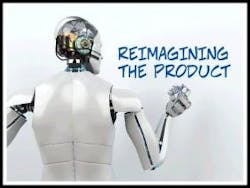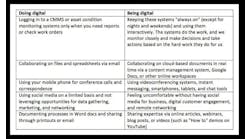Accenture’s Eric Schaeffer, global lead for the company’s Products Industry X.0 and Supply Chain and Operations consulting practice, believes that traditional products are transforming into smart connected products and ecosystem platforms at a rate much faster than most organizations think. Schaeffer, together with David Sovie, global high tech industry lead for Accenture, recently released the book Reinventing the Product, which makes a compelling case for companies to rethink their product strategy, their innovation and engineering processes, and organizational cultures in order to build future generations of “living products.”
Keith Larson, Smart Industry’s editor-in-chief, caught up with Schaeffer at this spring’s Hannover Messe trade fair in Germany. Here’s what Schaeffer had to say about how companies can best compete in the coming age of intelligent and potentially autonomous products that provide the more personalized and compelling experiences that today’s users, consumers and industrial enterprises expect.
Q: It’s been two years now since the publication of your book Industry X.0, in which you explored the essential aspects of the Industrial Internet of Things (IIoT), and how companies could begin to realize value from the implementation of digital technologies. What do see that has changed since then? Has industry progressed?
Accenture’s Eric Schaeffer
A: The first stage of digital transformation is about leveraging digital into your own operations to drive new levels of efficiency. That is Industry X.0. I think we now see evidence of that, and when you walk around Hannover Messe, you see that the idea is no longer forward-looking—it’s really happening. Many of our clients have implemented such technologies, but I think the issue they’re finding today is how to scale from proof-of-concept or from success in one plant to the rest of their manufacturing footprint. We’re now helping our clients to achieve scale and to make sure they get a return on their investment—that these projects impact their bottom line.
The second stage, which was also explored in the Digital Transformation Initiative work we did with the World Economic Forum a few years ago, is embedding digital technologies into products and services. This is the central theme of Reinventing the Product. Stage three is moving to the outcome- based economy. I’m not sure we’re there just yet, but we’re now seeing hints of it.
Today we are being asked by our manufacturing clients to help them drive their innovation and growth agenda by leveraging digital technology. They’re asking: How do I deliver products as services? How do I leverage artificial intelligence in my product to deliver a new experience? This is based not on my thinking that this is going to happen, but more on our clients saying: We’re transforming ourselves, now how do we transform our products and services to capture the new value spaces we see out there?
Q: So when you say smart products, you’re referring to consumer products as well as those used by organizations—everything from a smart tennis racket to an electric car, an air compressor or a packaging machine?
A: It can be any kind of product. We’re working on this same issue with our life sciences, pharmaceutical and med-tech clients as well as those who make consumer goods, automobiles and industrial equipment. I think they’re all seeing that there’s something out there for them.
Let’s take automotive. Everybody talks about it because it’s something everyone can relate to. But with the rise of car-sharing and the connected electric car, we’re seeing that both the original equipment manufacturers (OEMs) and the tier-one suppliers are thinking about the products of tomorrow. Faurecia, for example, makes car seats and is wondering what services they can provide inside the vehicle, and how they should reposition their products. The central questions are now: What is the Faurecia experience inside the vehicle, and what are the value-added services we can provide to the OEMs that they can they provide to their customers.
Q: You mentioned life sciences, food and beverage, and consumer packaged goods companies. What does the idea of a smart, connected product mean for a company that makes medicines, breakfast cereal, or shampoo?
A: It might not mean connected consumer products for a food and beverage company, although take a look at Unilever, which provides connected and smart coffee machines for the vending business. Or look at Drinkworks, which is the joint venture between AB InBev and Keurig in the United States. Drinkworks is creating a smart connected product around cocktails, but it’s their intent is to make this a platform for the home experience and then open it up to other brands. Then, once you’ve done this for cocktails can you do the same thing for beer? They’re asking what other services they can provide, and how can they continue to expand their footprint in the home but outside of their core business. Also, when you look at the future of food, it’s all about wellness and health. How does that drive new opportunities?
Q: Speaking of food and consumer packaged goods companies, I was just over to see Tetra Pak just yesterday here at Hannover Messe, and they were talking about smart connected packaging. It’s fascinating to see that despite the inherent disposability of packaging, technology now allows RFID tags to be printed on individual cartons so that consumers can see, for example, on what farm the hops in their craft beer were grown. It’s still relatively expensive, but already is being used on luxury goods.
A: Yes, when you think about Tetra Pak packaging as well Faurecia you’re talking smart surfaces and smart materials. At CES this year, Faurecia showed automotive door panels that have no need for audio speakers. Of course, companies that make speakers are looking at this and asking what’s next for them, now that speakers are integrated into the very construction of the vehicle interior.
It’s really interesting to see how with smart materials and digital technology, manufacturers can fundamentally change the user experience. At the same time, if you can add more and more intelligence and autonomy to the product, it opens tremendous opportunities to develop new services.
Q: One of the terms you introduced in Industry X.0 was that of the “living product.” Can you unpack that concept a bit for us?
A: Whether we call it a living product, Product X.0, or a smart connected product, it’s all about how intelligence and experience are transforming products and providing manufacturers the opportunity to tackle new value spaces. We’ve developed an analytical framework that we call the Product Reinvention Grid, which combines Product IQ, or intelligence quotient, increasing from traditional products to those that are connected, intelligent and autonomous.
We plot the IQ against the Experience Quotient, or EQ, which involves moving from outputs to outcomes. Selling services on top of your product is a first step on the EQ scale. The second step is selling product as a service, another way of moving from outputs to outcomes. The last step is around the ecosystem and how your product is either leveraging services or components from your ecosystem partners, or your product is becoming a part of an ecosystem. That ecosystem can be a closed ecosystem around your product and your brand, or it could be a more open ecosystem and you are just part of the overall value chain. You’re providing more and more experience to the end user, and that end user can be a consumer or a business.
When you combine the two, you drive what we call the Product Reinvention Quotient, which is the sum of the IQ and EQ. The higher the Product Reinvention Quotient the more change it calls for relative to a traditional offering—both from a product perspective because the product architecture will be completely different, but also from a business model perspective, as it opens up new business models.
In the end, we’ve identified five different values spaces that smart connected products support, none of which are better than the other. They can all be profitable but they all have their own rules of the game. Therefore, you need to choose as a manufacturer which of these new value spaces you want to play in.
Q: Is this really the choice of the company, or does the type of product one manufactures dictate the sort of value spaces that are most suitable?
A: Companies need to choose where they want to go, and also where their product road map allows them to play. I think it’s the combination of the two. My partner in crime [coauthor David Sovie] contends that today all manufacturers go to market in essentially the same way: they sell a product and they sell a bit of service to go on top of the product. Tomorrow, manufacturers will have to play in different value spaces, with each value space underpinned by a specific business model. They will have to go to market in multiple ways, which brings added complexity. So, manufacturers must look to deliver similar capabilities through multiple different models, which may be outcome-based, transaction-based, service-as-a-product or product-as-a-service. I think we’ve just touched the surface with this book, and that could lead to a third one.
Q: You positioned your Industry X.0 book as a kind of a guidebook for smaller organizations that may not the deep pockets to engage with a firm like Accenture for guidance. Does this second book also provide a prescriptive way forward?
A: With the framework outlined in Reinventing the Product, we want to make the reader pause and think. First, if I want to move into some new value space, what are the implications for my product and services portfolio? Second, what are the implications for my business capabilities in terms of engineering and technical disciplines as well as product development processes? Once the reader understands what needs to be done, it’s a question of how do I get there? We devote several chapters of the book to how to make it happen; what are the markers of success, the several things you must do to get it right.
The last part of the book is devoted to case studies, describing our work with companies like Faurecia. We have Signify, formerly Phillips Lighting, on how they moved to their smart connected journey. Also, the Haier Group out of China and how they moved to smart, connected home appliances. And then we’ve got a relatively small company out of the U.S. called Symmons, a manufacturer of plumbing fixtures that is moving to outcome-based offerings such as an outstanding shower experience for its hospitality clients. More than 25 companies are represented—from ABB to Tesla.
It’s the CEOs of these companies along with their teams telling these stories, sharing how they came to transform their products, the reasoning behind the digital technologies they’ve included in their products and the value spaces they’re now going after. The things that worked—and the things that did not. It’s this mixing of voices that provides a new perspective.





